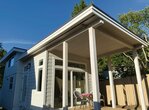


A tiny home situated in Point Whitehorn is one of the newest builds for West Coast Homes, and the first in the Blaine and Birch Bay area.
Homeowner Symone Maruyama said she and her husband, Reo, had been looking for options where Reo’s mother could stay for long visits when they found West Coast Homes. One of the company’s 400-square-foot tiny homes fit their needs: It had a living room, kitchen with full-sized appliances, bathroom and deck on the first floor, with an upstairs sleeping loft and attic. Symone Maruyama said the home had a clean and modern look that could provide a peaceful space for her mother-in-law to spend weeks at a time.
“It fit the bill,” she said.
West Coast Homes is the residential division of Lynden-based Faber Construction specializing in tiny homes, park models, accessory dwelling units and modular homes. The division formed in 2011, and soon after Faber Construction was asked to build over 40 park models at Wildwood Lakefront Cottages on the south end of Lake Whatcom.
Raymond Faber, business development manager at Faber Construction, said the company saw it had a viable business model after creating the Wildwood homes. He added the smaller homes aligned with the company’s passion for affordable housing and provided an avenue for creativity.
“It touches a lot of our core values,” Faber said.
The tiny homes and park models generally range from $120,000 to $200,000, and typically take about three to four months to build, with additional time needed for permitting.
The park models and tiny homes are similar and about the same size, Faber said, adding one of their biggest differences is they follow different building codes. Tiny homes are considered permanent dwellings and can be mortgaged, while park models are considered to be a recreational trailer.
West Coast Homes offers two layouts for tiny homes and five layouts for park models, with more layouts in the works. While the footprint can’t be changed because of permitting, Faber said people can select most finishes, such as the cabinetry, countertops, paint colors, tile and siding.
For example, the Maruyamas chose the Bellevue tiny home model but opted out of a fireplace, changed the stove, added a water filter, and selected black finishes and whitewashed wood.
West Coast Homes uses material that it would use in a regular house, such as drywall, 24-gauge metal roofing or TPO roofing, and plenty of insulation. The company’s tiny homes are also built to the Washington State Energy Code.
“We don’t want to be cheap. We want to be good quality and we want it to last,” Faber said. “If I’m building my home with my name on it, I want it to be good quality.”
Once the home is constructed, the homeowner is responsible for moving it to their property.
The company has built about 60 tiny homes in the past decade. Faber said he sees the homes being moved to areas in northwest Washington, especially on the islands, and Okanogan County in eastern Washington.
Symone Maruyama said she recommends people interested in adding a tiny home to their property look into permitting to figure out how much space they’re allowed before looking at houses.
“The team was so helpful with getting us through the permitting process,” she said.
West Coast Homes has a short survey for people who are interested in their services that includes questions about the timeline, budget, model and final location for their tiny home. For more information about West Coast Homes, visit westcoast-homes.com.
Comments
No comments on this item Please log in to comment by clicking here